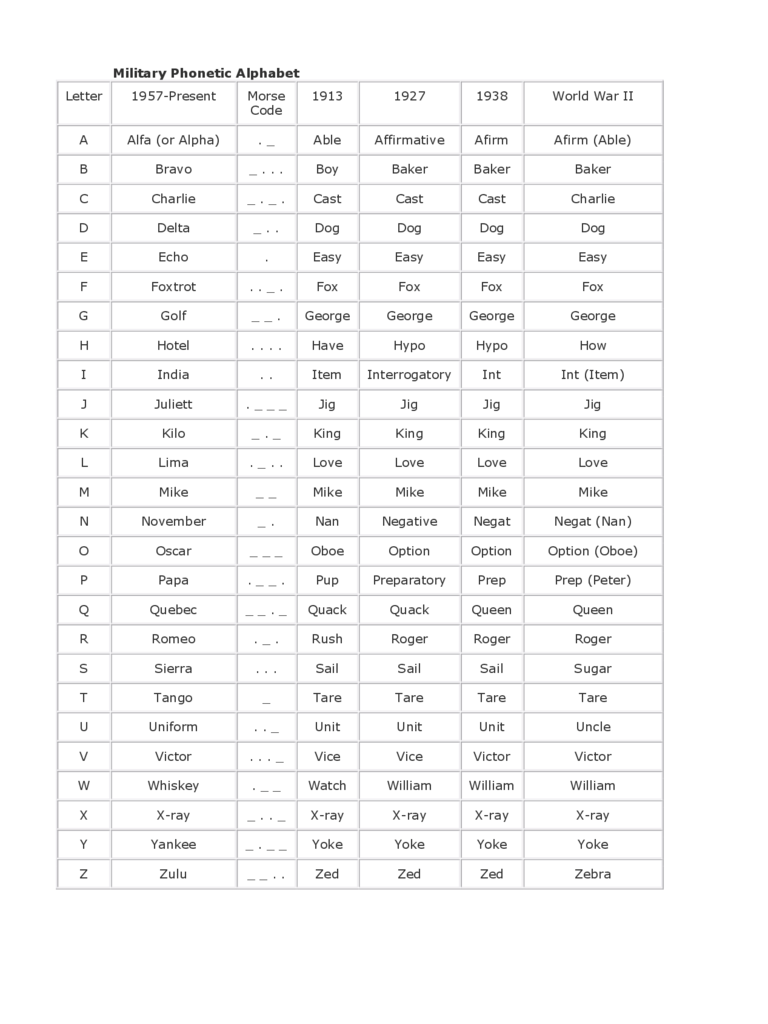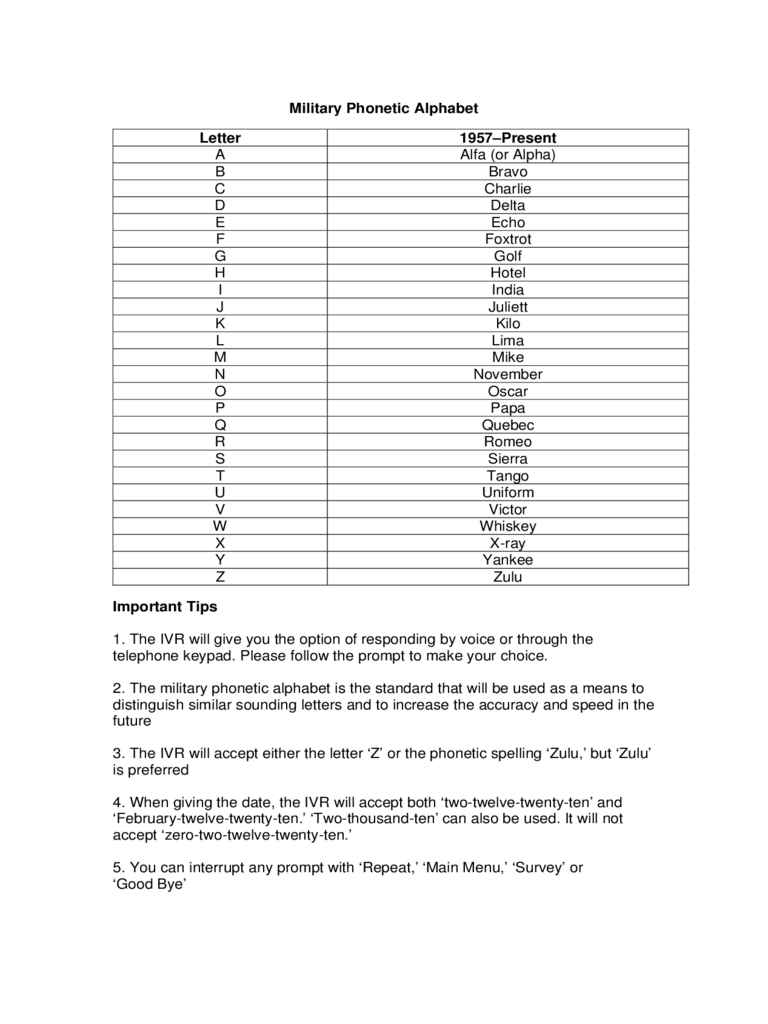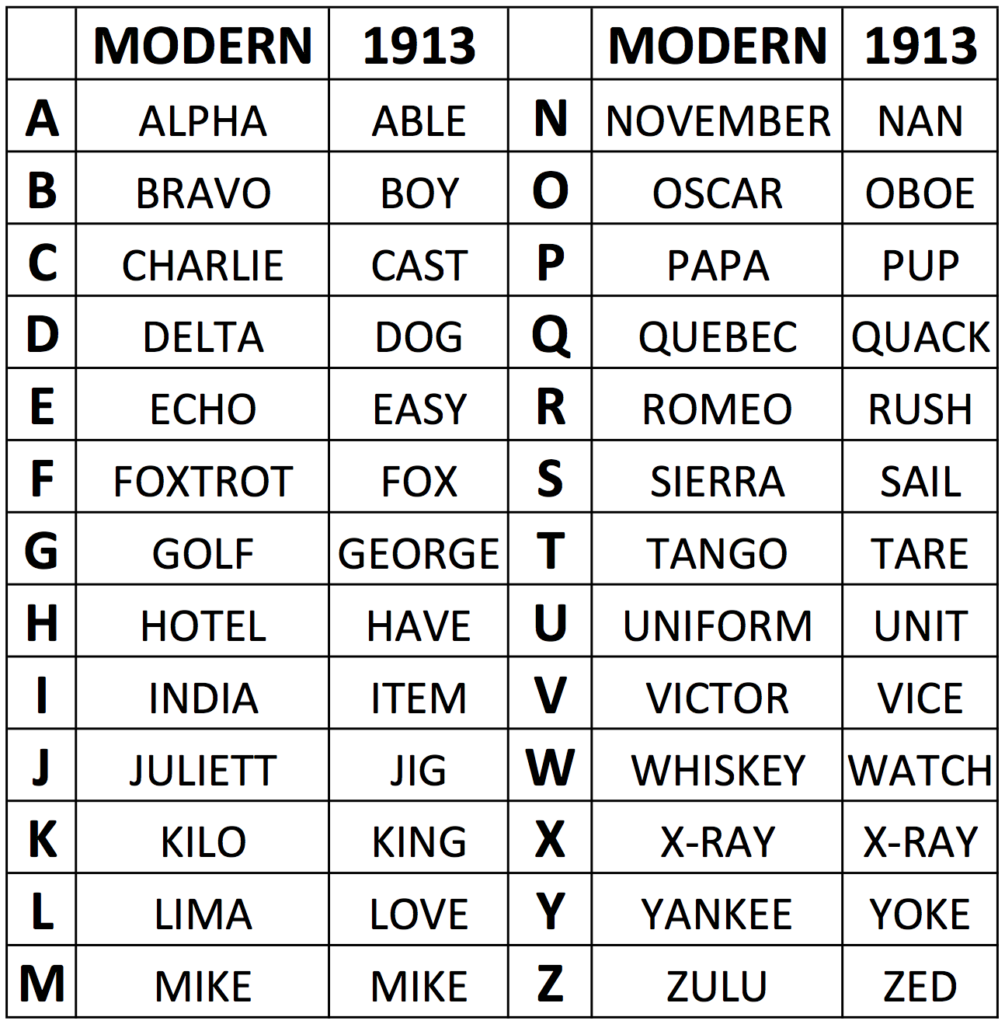Hey there! Today I want to talk to you about something interesting and practical - the military phonetic alphabet. Have you ever wondered how soldiers and military personnel communicate effectively, especially when it comes to spelling out words or conveying information accurately over the radio or phone?
Well, the military phonetic alphabet is the secret behind their clear communication. This system uses a set of standardized words to represent each letter of the alphabet, making it easier to transmit precise information and eliminate any confusion that might arise due to different accents or unclear pronunciation.
Let’s take a look at this Military Alphabet Chart:
 As you can see in the chart above, each letter is represented by a specific word. For example, instead of saying “A” for the letter ‘A’, military personnel would say “Alpha.” Similarly, “B” becomes “Bravo,” “C” becomes “Charlie,” and so on. This way, even if there are communication disruptions or background noise, the message can be transmitted clearly.
As you can see in the chart above, each letter is represented by a specific word. For example, instead of saying “A” for the letter ‘A’, military personnel would say “Alpha.” Similarly, “B” becomes “Bravo,” “C” becomes “Charlie,” and so on. This way, even if there are communication disruptions or background noise, the message can be transmitted clearly.
The military phonetic alphabet has proven to be invaluable not only in military operations but also in various civilian applications. For instance, airline pilots, police officers, and emergency responders often use this system to avoid any misinterpretation or misunderstanding while communicating important information.
Here’s another Military Alphabet Chart:
 Each image provides a visual guide to help you memorize the military phonetic alphabet. Trust me, once you get the hang of it, it becomes second nature and you’ll wonder how you ever communicated without it!
Each image provides a visual guide to help you memorize the military phonetic alphabet. Trust me, once you get the hang of it, it becomes second nature and you’ll wonder how you ever communicated without it!
Of course, there are various resources available where you can find these charts. Here’s one more to check out:
 The military phonetic alphabet is not just practical; it also has a rich history behind it. It originated from the International Radiotelephony Spelling Alphabet, and the version we know today as the NATO phonetic alphabet was adopted in the 1950s. It was developed as a universal standard to ensure accurate and efficient communication among different nations and military organizations.
The military phonetic alphabet is not just practical; it also has a rich history behind it. It originated from the International Radiotelephony Spelling Alphabet, and the version we know today as the NATO phonetic alphabet was adopted in the 1950s. It was developed as a universal standard to ensure accurate and efficient communication among different nations and military organizations.
Now, you might be wondering why it matters for us non-military folks. Well, let me give you a scenario. Imagine you are trying to communicate a license plate number over a noisy radio to a police officer or provide your flight number to an airline representative. Using the military phonetic alphabet ensures that there are no misunderstandings or errors due to similar-sounding letters or ambiguous pronunciation.
Take a look at this Military Alphabet Chart as well:
 Isn’t it fascinating how such a simple system can make such a big difference in effective communication? But what about situations where there is no chart readily available? Don’t worry, with a little practice and repetition, you’ll soon find yourself rattling off the military phonetic alphabet without even thinking twice!
Isn’t it fascinating how such a simple system can make such a big difference in effective communication? But what about situations where there is no chart readily available? Don’t worry, with a little practice and repetition, you’ll soon find yourself rattling off the military phonetic alphabet without even thinking twice!
So, whether you’re a military enthusiast, someone who loves to learn new things, or simply looking to improve your communication skills, exploring the military phonetic alphabet is definitely worth your time. Here’s another chart that you can refer to:
 As you can see, it’s not just a random list of words; each word is carefully chosen to be distinct and easy to understand, even in challenging conditions. For example, “Hotel” is used for ‘H’ because it sounds different from other words and stands out. It’s this kind of attention to detail that makes the military phonetic alphabet so effective.
As you can see, it’s not just a random list of words; each word is carefully chosen to be distinct and easy to understand, even in challenging conditions. For example, “Hotel” is used for ‘H’ because it sounds different from other words and stands out. It’s this kind of attention to detail that makes the military phonetic alphabet so effective.
Another interesting fact:
 The military phonetic alphabet has also found its way into popular culture. You might have come across it in movies or TV shows where military personnel are communicating over the radio. It adds authenticity and helps viewers understand what’s being communicated.
The military phonetic alphabet has also found its way into popular culture. You might have come across it in movies or TV shows where military personnel are communicating over the radio. It adds authenticity and helps viewers understand what’s being communicated.
Here’s another chart that you might find useful:
 Now that you know about the military phonetic alphabet, next time you hear someone saying “Bravo Echo Romeo Yankee,” you’ll know exactly what they mean - “Berry”!
Now that you know about the military phonetic alphabet, next time you hear someone saying “Bravo Echo Romeo Yankee,” you’ll know exactly what they mean - “Berry”!
So, go ahead and give it a try. Familiarize yourself with the military phonetic alphabet, and before you know it, you’ll be part of an exclusive club of people who can communicate clearly and effectively, just like the military!
One last Military Alphabet Chart for you:
 Now you’re armed with the knowledge to become an excellent communicator, no matter the circumstances. Remember, practice makes perfect, so start incorporating the military phonetic alphabet into your daily life and notice how it improves your clarity and precision in communication.
Now you’re armed with the knowledge to become an excellent communicator, no matter the circumstances. Remember, practice makes perfect, so start incorporating the military phonetic alphabet into your daily life and notice how it improves your clarity and precision in communication.
That’s all for now, folks! I hope you found this insight into the military phonetic alphabet informative and intriguing. Until next time, stay curious and keep exploring!